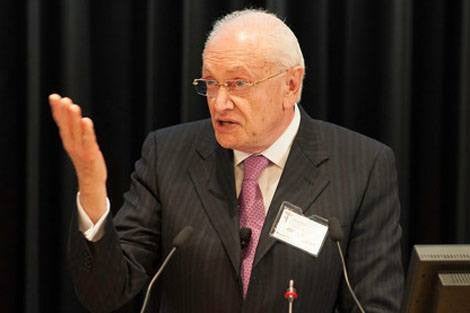May 13, 2013 — In 1854, in the midst of a cholera epidemic in Soho, London, English doctor John Snow drew up a map that showed a cluster of cholera cases surrounding a water pump on Broad Street. The pump was removed, the epidemic waned, and Snow’s work is often cited as a telling example of how an epidemiologic study can lead to real-world public health benefits.
This is just one example of the importance of “translational epidemiology,” Moyses Szklo told a Harvard School of Public Health (HSPH) audience in Snyder Auditorium on May 1, 2013. “It’s terribly important for epidemiologists to get involved with policy,” he said.
Szklo’s talk—the 157th Cutter Lecture on Preventive Medicine—was titled “Semantic and Other Challenges in Translational Epidemiology.” Szklo is professor of epidemiology and medicine in the Department of Epidemiology at Johns Hopkins University. He is also principal investigator of two of the largest cohort studies of atherosclerosis (hardening of the arteries) and has been editor-in-chief of the American Journal of Epidemiology since 1988.
The Cutter Lecture is named for John Clarence Cutter, a graduate of Harvard Medical School, who left a bequest to Harvard to support a lecture series on preventive medicine. The first Cutter lecture was delivered in March 1912. The lectures are administered by HSPH’s Department of Epidemiology.
Defining translational epidemiology
Epidemiology is the study of patterns, causes, and effects of health in defined populations. Szklo defined “translational epidemiology” as the effective transfer of new knowledge from epidemiologic studies into the planning of population-wide and individual-level disease control programs and policies.
In addition to Snow’s famous work, Szklo cited a number of other public health policies influenced by epidemiologic findings, including cigarette advertising bans, food labeling requirements, and air pollution standards.
Szklo also discussed a variety of issues to think about when “translating” epidemiologic knowledge into interventions, programs, or policies. For example, he said, it is important to consider whether or not a particular association between one risk factor and a disease is “confounded”—if it is to some extent questionable because there are one or more other risk factors also at play.
“Translational epidemiology is not an exact science,” Szklo noted. “It’s judgment.”
In a question-and-answer session at the end of the presentation, HSPH’s [[Walter Willett]], chair of the Department of Nutrition and professor of epidemiology and nutrition, asked what Szklo thought of the notion that epidemiologists should not become involved in policy because it makes them less objective in evaluating their data.
Szklo acknowledged that while such involvement might pose a problem, “I don’t think it’s possible to talk about development of [health-related] policies without strong input from epidemiologists.”
photo: Aubrey LaMedica
